The Perfect 10: Beauty Pageant art series
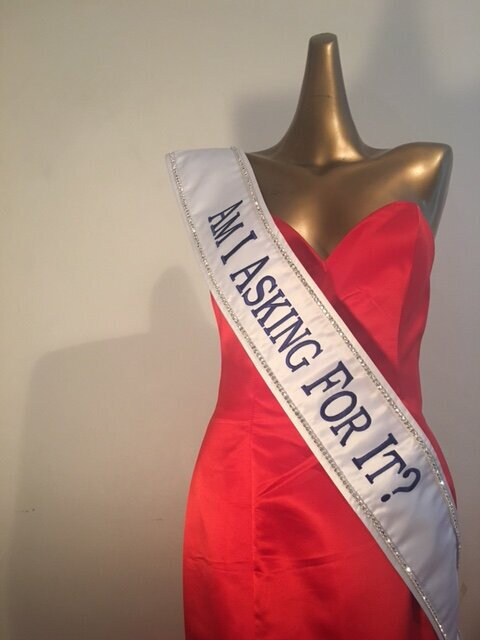



Attributions and Artist Statement
Perfect 10
4 evening gowns
4 beauty pageant sashes with rhinestones
1 gold mannequin
life-size
Prototypes of the Perfect 10: Beauty Pageant Series were first made in 1995, for a Revolution Rising multi-media benefit at the Macondo, an all-ages club in Los Angeles. I was very poor, so I used the clothes in my closet (a black slip, and black tank tops with pink or white skirts) along with shiny pink wrapping paper ribbon or scraps of pink cotton or blue jean for the sash. I wrote the sash messages with a black sharpie. The clothing with sashes were displayed on gold wire hangers.
I'm a fan of Hole's music, and was reminded by Courtney Love's lyrics of questions my best friend and I would ask each other: Does this make me look fat? Am I pretty from the back? And, underneath it all, am I pretty on the inside?
Am I asking for it?
When Donald Trump ran for President of the United States in 2016, his owning a beauty contest and calling one of the winners fat enraged me, as did his saying he grabs women by the pussy.
He also said because he owned beauty pageants, he could “inspect” the contestants as they dressed backstage.
Trump totally inspired my current reimagining of my art installations, as did memories of my father, who once told me, when I was 15, that I better focus on my mind because I'd never win any beauty contests. (For some reason I didn't feel anything when my father said that, and I knew he was right. But...I've never forgotten it, either.)
#MeToo questions the way women are objectified, implicating sexual abusers.
I had more money making the art this time around because after I was recently laid off by a company whose primary investor is Goldman Sachs, I received a severance package of nine weeks pay in one paycheck. Goldman Sachs is a mainstay in Trump's administration. I like that I am using the money I earned from a company and investor I don't respect to do something I do respect.
I chose a gold mannequin because all nationalities have gold tones, and I wanted to suggest a global experience of being a girl or woman in patriarchy. Plus, as my mom said about diversity and equality, all skin tones shimmer.
I bought the evening gowns and gold mannequin in downtown Los Angeles on Santee Street, and the satin with rhinestone sashes were made by a company that makes sashes for the Miss America pageant.
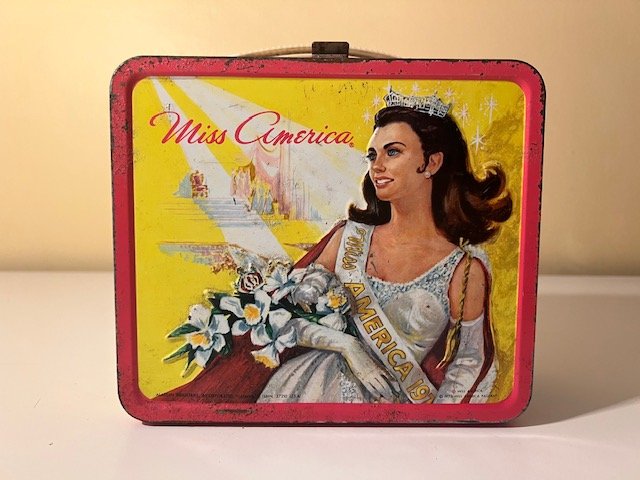
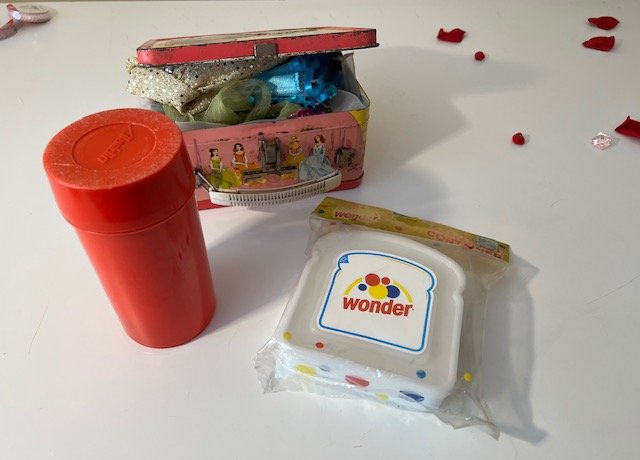
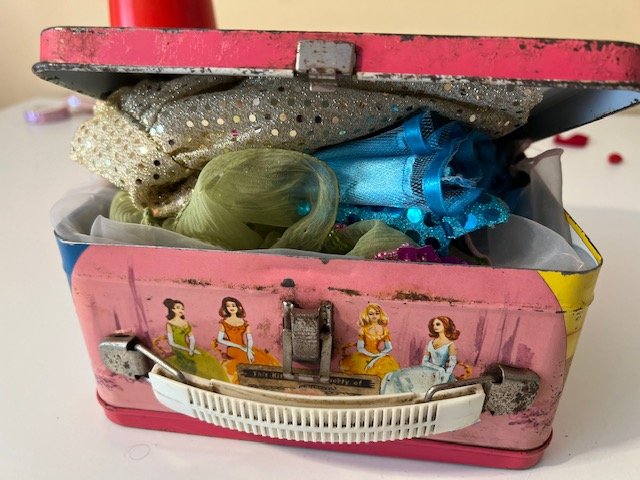
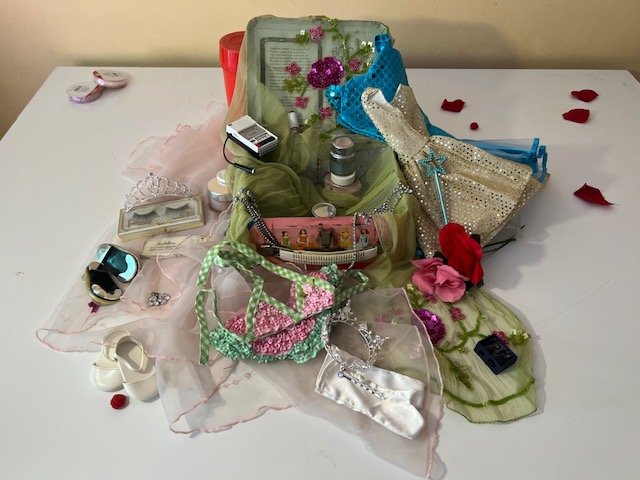
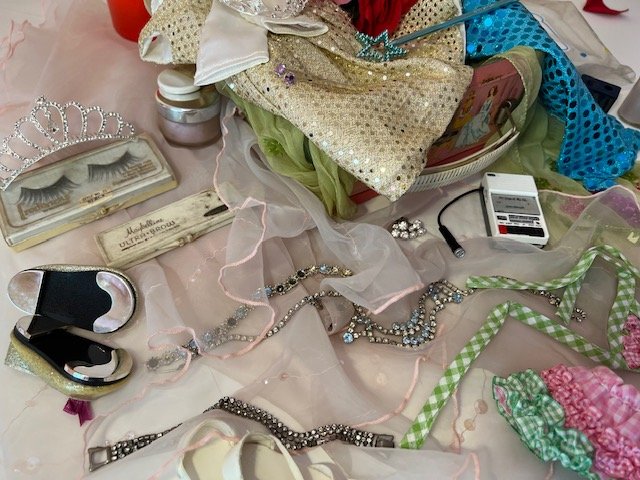
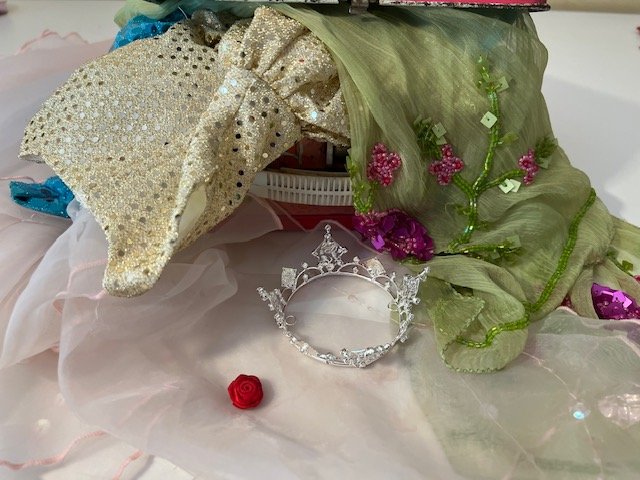


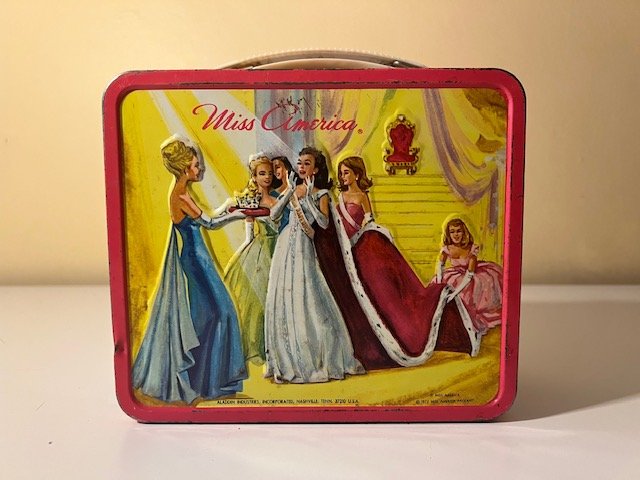
Attributions and Artist Statement
Miss America’s Lunchbox
Lunchbox unopened
7 1/2” w
6 1/2” h
4” d
Lunchbox with thermos of roses, tiara, petals, pink gemstone, sparkly ribbons, and Wonder sandwich
26 1/2” w
12” h
31” d
Lunchbox opened
7 1/2” - 14 1/2” w
8” - 10” h
4” d
Lunchbox opened with contents arrayed
26 1/2” w
11” h
35” d
1 Miss America primarily red and yellow lunchbox
1 Miss America red thermos
1 Wonder Bread sandwich container with plastic cover with yellow and red circles design
1 semi-sheer green scarf with flower pattern made of green and dark pink beading (given to me by my cousin, the artist Constance Ward)
1 semi-sheer pink scarf with pink sequins
American Girl clothing: pink, green and white checked two-piece swimsuit; blue sequin fishtail gown; gold sequin party dress; white satin elbow-length gloves; gold sparkle tap shoes; white casually formal shoes
1 American Girl scepter with sparkly blue star
1 American Girl sparkly tiara
1 American Girl sparkly crown
1 American Girl tape recorder with microphone
Make-up I had in the 1960s, 1970’s, 1980’s, 1990s, and 2000s: lip color; Frederick’s of Hollywood eyelashes; Maybelline eyebrow color; glimmer lavender face powder; pink and blue powder; pink powder; small white semi-circle make-up brush. The eyebrow color was my mom’s, Lucretia Baldwin “Teka” Ward, and my grandmother, Lucretia Baldwin “Lukey” Ward, gave the false eyelashes to me when I was eleven years old. Fun!
Jewelry I’ve had since the 1970s and 1980s: blue and white rhinestone necklace; blue and white rhinestone bracelet; rhinestone triple strand bracelet; one pair faux diamond earrings
4 deep red rose petals made of fabric
2 tiny cloth roses
2 fake flowers, one pink and one red, each on green stems
1 pink faux gemstone
2 rolls of stitching: one pink sequin, one sparkly lavender knit
2024
Miss America began in 1921 amidst the suffrage movement, when women fought for the right to vote. The pageant began as a bathing suit contest, something that makes one pause in its emphasis on the female body, an emphasis that has created serious struggles from eating disorders to birth control access to safe and legal abortions, an emphasis challenged by those who want equal rights, to move freely in the world, and to be perceived as more than a sex object.
But it also relates to sexual liberation, and the removal of body shame and inhibition.
For a month I watched over forty episodes of Miss America. I’d occasionally watched the pageant before that, and really loved it, even though the swimsuit competition made it clear that women’s bodies had to fit a standard (and for me, a devastatingly unattainable) body type. The site of the wound became the site of the transformation.
During that month, I was healing from a serious illness. For a few months before that, I couldn’t eat. I couldn’t get out of bed. I couldn’t do the simplest chores. I was nauseous and retching daily even though I had not eaten. I began to see my life and being alive in a whole new way. I understood eating in a whole new way. These were revelations.
When I was 14 in 1980, my father told me I’d never win any beauty contests. I’m not sure why he said that because I was under no delusion that I would. He also told me to try bulimia.
I took to bulimia. It ruled my life for ten years. But it wasn’t until I was in my thirties and on a somewhat healthy food plan that I dropped the fifty pounds that had plagued me most of my life. It was so exciting! I’d never known what it was like not to be scared to look in a mirror, or at a photograph of myself, or to try on clothes or weigh myself or just be naked.
I gained it all - slowly, excruciatingly - back by the time I was forty years old. It felt so…sorrowful. I just couldn’t get the weight off for the next eighteen years.
I lost the weight again with the recent illness. It sure wasn’t exciting this time. It was scary.
When I couldn’t eat, I realized how eating disordered and shame-based my relationship with food was all my life. I decided that if I ever got my taste buds back that I was going to enjoy without shame every bite, and love my body. All that matters is good health, actually enjoying the sensations that give pleasure - for example, wind on the skin, the fragrance of flowers, the taste of food! - and love. Being kind as much as possible. I decided I would figure out how to love my life and being alive even amidst the fear, suffering, and misery of being alive. It’s very difficult sometimes to do that because of war, rape, slaughterhouses. Health challenges can take all the energy needed for a good attitude. Also the pains and hurts of trying to communicate and deal with humans on any level can be exhausting and/or devastating!
I’m convinced the pageant and making this art assemblage about it helped me heal. They made me feel happy. I was going through one the most difficult times of my life, and one of the scariest, and Miss America made me happy. I understood the contest in an entirely new way.
I watched Miss America episodes that ranged from the 1960s - 2024. When I was younger, I thought the contestants were people who fit in society, and who fit into the best clothes, so unlike weirdo me. So I rarely watched the program. But I never liked when people made fun of the pageant or it’s contestants; it‘s cruel to make fun of anyone. Plus, I seriously doubted the contestants were dumb, and thought it was sexist and illogical to judge pretty women as stupid.
In my 30s, in the early 2000s, I suddenly loved watching the pageant. And this year I got so invested that I felt the sadness of those who didn’t “win” and the joy of those who did. I actually cried along with some of the contestants.
As I watched so many of the contests, I became curious about the changes I could see and sense; I did some research and learned about so many of the changes, pageantry changes that reflect societal changes, too.
Combining expectations about behavior and brains with beauty and poise, the pageant began as a beauty contest but in 1935 curfews and a ban on bars meant Miss America also had “morality.” The pageant was closed from 1928-1932 because many wondered if the Hollywood hopefuls were “moral.” Sponsorship by companies such as theaters or stores also created suspicion; with contestants represented by state in 1938, a sense of family was represented by an individual’s homestate. Contestants representing states in the United States rather than theaters, resorts, or cities suggests to me the formation of the contest as a sport, and how humans tend to organize themselves by affiliation. It’s like the United States Senate. It also shows, I think, the view of women as national morale booster.
Also in 1938, a talent portion was added to the contest. And in 1945, college scholarships became the prize. Adding scholarships lent gravitas to the pageant. Today, the contest awards many scholarships, the swimsuit portion is referred to as fitness rather than beauty, and the winner spends her year advocating on a national tour for the cause of her choice. She gets to experience travel and the promise of an education she chooses. I think this shows the evolving perception and power of women.
Until 1948, Miss America was crowned in her swim suit, and then the evening gown replaced her bathing suit for the crowning moment. In 1968, women’s liberation groups protested the beauty contest, and the “Freedom Trash Can” - in which feminists tossed bras, girdles, false eyelashes, wigs, beauty and fashion magazines - became a symbol of feminist activist art. In 1969, feminists protested the pageant and crowned a sheep, an example of the usual equation of females with animals. Contestants could hear the chanting of the protestors outside the venue: “Freedom!” It’s a paradox: women on the inside vying for a crown that honors their beauty and achievements while women on the outside vie for freedom from it: the crown demands allegiance to narrow definitions of beauty and success. Amy Argetsinger and Lauren Collins point out that soon after the Constitution was ratified to ensure women could vote, they were voted upon; Miss America emerged about a year after the ratification. But I wonder: could it be that the contest was proclaiming women’s importance?
There have been many rules about competing for Miss America, including rules about age, weight, and being childless and unmarried. In the 1930s, a rule was added that Miss America had to be white. In 1945, the first Jewish Miss America didn’t receive the usual endorsements and advertising spots. And that was the year the cash money prize was replaced with scholarship money, so women could more likely go to college!
In 1969, Miss Black America was founded, and, in 1970, the Miss America rules were changed so Black women could be Miss America, too. In 1984, the first Black woman to win the Miss America crown (1983) resigned because of her nude photos - and then became one of the judges in the pageant in 2015!
In 1989, the pageant made social issues a required platform of commitment, demonstrating to me that one person’s actions really do make a difference: the year before. Miss America devoted herself to a social cause for the first time.
In one of my favorite episodes, a 2019 biochemist contestant integrated science in her talent segment. So cool! All the multi-colored billowing foam, orange green blue! A contestant also did a similar experiment in 2016, so cool, and her words helped me understand chemistry and physics for the first time in my life.
In 1995, a deaf contestant competed.
It was fascinating seeing the changes in the pageant, and in standards of beauty and success, over the years. Also, how the women composed their bodies in space changed. In earlier contests, the women moved their bodies less. They were more like serene and smiling dolls. Now, the women’s bodies move in many directions and all at once, with more emotional variety. More like being animated. Over the years, Q & A developed, which meant the women were talking, showcasing personalities, voice inflections and timbres, intelligence and accents. Candidates improvised, speaking off the cuff and more conversationally. I noticed that the women walked differently, too. In earlier pageants, women took smaller steps. Today, the women stride. Candidates have more physical freedom, and move in ways that prove it. It’s like watching power emerge.
Plus, there’s a lot more glitter, shorter skirts, and body diversity; some women don’t fit the beauty standard, which is thrilling to me. Leg lengths, nose shapes, skin tones, hair textures - more and more over the years I noticed varieties on that shining stage. And not all contestants have flat tummies!
And although it’s long infuriated me that women earn less than men for equal work, Miss America made it even more baffling because I could actually witness the multi-talented strength of the women competing. I can’t emphasize enough how much skill, intelligence, determination and talent the Miss America pageant requires. It’s awe-inspiring to see and hear contestants present in the evening gown, swimsuit, talent and interview or quiz segments, and to observe them all as they perform as a group the dance segments, which they do even after they’ve “lost.”
The pageant was first televised in 1954. From 1955-1979, Bert Parks was the host. He provided a gallant and goofy vibe! His performance background and his resonant voice were disarmingly charming. When he guest-starred and sang the theme song in the 1990 pageant, he described his painful layoff as “before I was rudely interrupted,” a lovely way to express his hurt feelings with humor.
From 1955-1979, Bert serenaded the winner by singing “There She Is” as she walked the runway after winning. She wore her new crown and sometimes her cape, scepter, and/or flowers as he sang. It reminds me of musicians and groupies! But this time the girl plucked from the audience gets a scholarship. The theme song was written by Bernie Wayne, introduced on television in 1955, and it’s lyric “your ideal” signifies the mighty hopes and tremendous pressures of being Miss America.
I think every contestant on that stage is a winner. I really like that the pageant awards a scholarship to Miss America and also to the other contestants. I like that it’s a nonprofit organization. It’s interesting to me that the foundation may continue to exist because many of the contestants themselves raise the money to keep it going; its means women are upholding a pageant that some think put them down. Have we been brainwashed into a cult of beauty, what Naomi Wolfe called the beauty myth, or is there something more to the contest? Are we being colonized, or are we being empowered?
My art assemblage is about the contest. What does Miss America eat for lunch? Everything sparkly and pretty and empowering. The contestants may seem edible in their confectionary glitz, their tantalizing allure a delicious spectacle, but instead of the usual dismissive belittlement and cruel exploitation that eco-feminists have correctly perceived in the history of patriarchy and food consumption, I see Miss America and my Miss America lunchbox art as proof of each individual woman’s unique power. Her four-pointed crown represents the four pillars of her reign: scholarship, service, style, and success.
I chose American Girl accessories because Miss America is an American female. In the lunchbox is an outfit or item that represents each portion of the pageant - swimsuit for fitness, tap shoes for talent, sparkly gown for evening gown, tape recorder for interview - along with make-up and jewels, a thermos and a sandwich box. Rose petals, a scepter, and her crown.
Bibliography
Museum of the American Revolution. https://www.amrevmuseum.org/virtualexhibits/when-women-lost-the-vote-a-revolutionary-story Accessed online 10.28.24.
Argetsinger, Amy. There She Was: The Secret History of Miss America. USA: Atria, 2022.
Collins, Lauren. “Miss America’s History-Makers and Rule-Breakers.” The New Yorker. August 31, 2020. https://www.newyorker.com/magazine/2020/09/07/miss-americas-history-makers-and-rule-breakers Accessed online 10.28.24.
“Four Points of the Crown and Four Winning Tips.” Four Points. April 30, 2013.
https://fourpointsmagazine.com/resources/item/1019-four-points-of-the-crown-and-four-winning-tips Accessed online 7.7.24.
“Miss America: A History.” Miss America.org.
https://www.missamerica.org/history/ Accessed online 7.7.24.
“Miss America Breaking the Color Line.” American Experience. PBS.
https://www.pbs.org/wgbh/americanexperience/features/missamerica-breaking-color-line/#:~:text=Instituted%20under%20the%20directorship%20of,they%20could%20trace%20their%20ancestry. Accessed online 9.8.24.
“Miss America Timeline.” American Experience. PBS.
https://www.pbs.org/wgbh/americanexperience/features/miss-america-timeline/ Accessed online 7.7.24.
Secrets of Miss America. https://www.imdb.com/title/tt27998992/ Accessed streaming, April-July, 2024.
“The Miss America Organization and Pageant Icons.” American Experience. PBS. https://www.pbs.org/wgbh/americanexperience/features/miss-america-organization-and-pageant-icons/ Digital link. Accessed 9.24.24.
Watson, Elwood and Darcy Martin, eds. “There She Is, Miss America”: The Politics of Sex, Beauty, and Race in America’s Most Famous Pageant”. USA: Palgrave MacMillan, 2004.

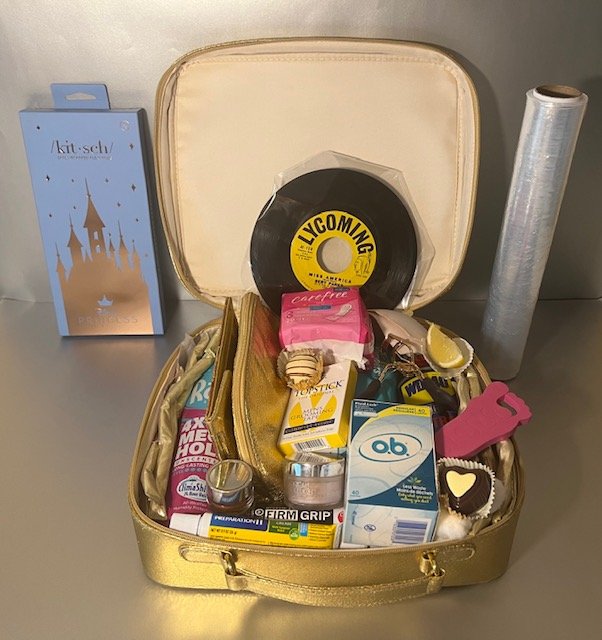


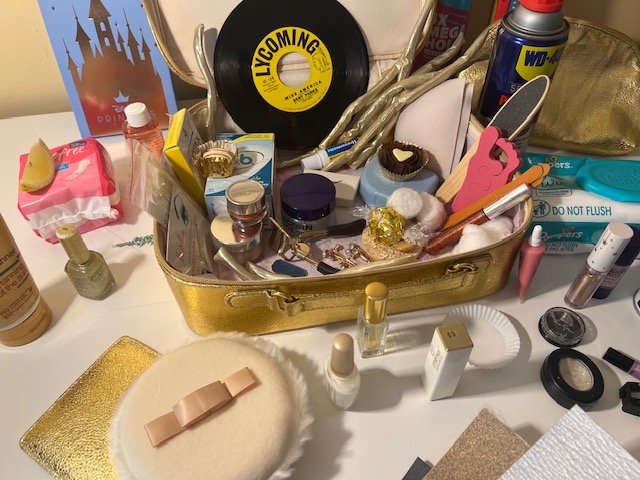
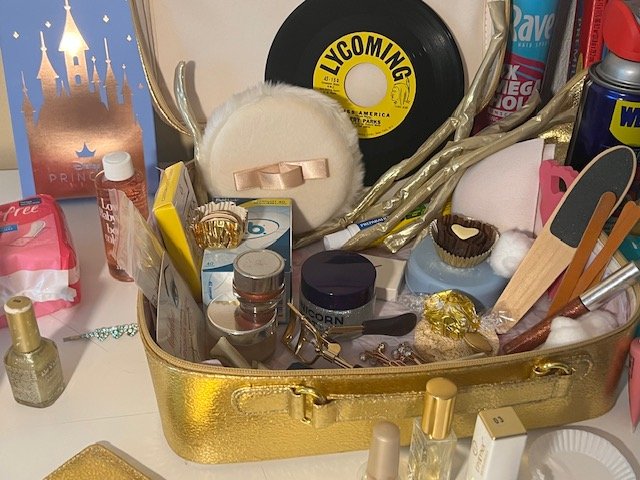

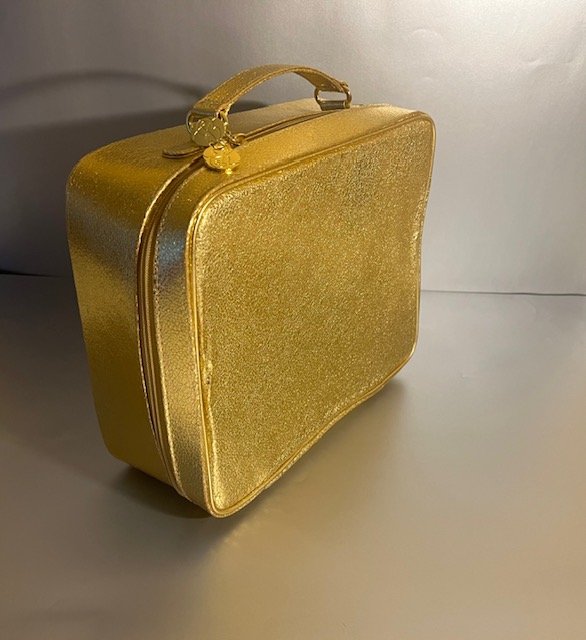

"The Mystery of Miss America's Make-Up Case"
The Beauty Pageant Art Series
Artist Statement and Attributions
12 1/4" length up/down x 12 3/4" width across x 4 1/2" depth when it’s all packed up, with variable dimensions when contents arrayed
Gold cosmetics bag with handle
Gold mirror
Gold cosmetics bag with zipper
Black velvet jewelry box
Blue velvet jewelry case
Pink jewelry gift box
Star-tipped sceptre to represent a baton, by American Girl
Flower print paper in blue and in lavender by LoveShackFancy
Disney Princess /kit-sch/ satin-wrapped flexi rods in a blue box of a gold castle with gold stars
Silver paper background
Pearl necklace
Rhinestone rings
Rhinestone drop and stud earrings in: pink, diamond, purple
Gold thread button
Vino Lux body lotion in champagne, by the Grapeseed Company
Jasmine Midnight Blooms body mist by Voluspa
Love’s Baby Soft body cologne after bath fragrance by Menley & James
Bronze Goddess Mermaid Waves sea salt spray by the Grapeseed Company for the hair so it looks fresh, sparkly and tousled (as a reference to the pageant’s origins as a bathing beauty contest)
Rose Gold Mermaid Waves sea salt spray by the Grapeseed Company for the hair so it looks fresh, sparkly and tousled (as a reference to the pageant’s origins as a bathing beauty contest)
Gold hair curlers
Gold body with rhinestone-tipped hair clips
Clear body black nylon bristle mascara brush #10G by Maybelline
Pink and white mascara rhinestones
Eyeshadow Coloricon Glitter Single C356C Spiked by Wet n Wild
Eyeshadow Coloricon Glitter Single C351C Bleached by Wet n Wild
Eyeshadow Coloricon Glitter Single C354C Brass by Wet n Wild
Coloricon multistick 258A Lavender Bliss by Wet n Wild
Cake eyeliner EL-1 Black by Ben Nye
Clay Cream eyeshadow Seashell Pink by Tarte
Glitter Glitter liner Stellar by Moira
Lights Camera Lashes mascara by Tarte
Sea blue eyeshadow
Matte lipstick 03 by EpiLynx
Hot Currant 5 Lip Lights by Max Factor
Gold pleated bon bon wrapper
Nude pleated bon bon wrapper
White pleated bon bon wrapper
Caramel color pleated bon bon wrapper
2-3 lip gloss bon bons by Advanced Healthcare (gloss for so lips look shiny and catch the light) - round white chocolate; heart-shaped dark chocolate with red stripe icing; and round dark chocolate with white icing
Vanilla Frosting scented lip gloss by Black Opal
Lip Tar matte with brush by Obsessive Compulsive Cosmetics
Red and orange glitter lipgloss 133 598
Powder puff with beige ribbon
Lavendar Candlelights Face and Body Lights by L’Oréal (this is powder I wear to flatter my skin tone. Madame X (of the John Singer Sargent 1883-1884 painting) wore lavendar powder, and Cherry Vanilla (Warhol Superstar, David Bowie’s publicist, writer and Super Groupie) made sure to have lavendar gels for the lighting when she performed onstage)
Unicorn Snot face and body glitter gel
Unicorn Snot Lightning Drops liquid highlighter Nymph
White nail lacquer 30A by Milani
Precious Metals nail enamel 356 14k/14 k by Wet ‘n’ Wild
45 vinyl record with sleeve, Bert Parks sings “Miss America” and “Miss America Sisters”
Topstick men’s grooming tape by Vapon (to uplift breasts)
Fearless body and clothing tape by Walker Tape (to uplift breasts and keep clothing in place)
Hair spray by Rave (this item can also keep clothes in place)
Preparation H hemorrhoidal cream (so eyes aren’t puffy)
WD-40 (to spray under bathing suits so they stay in place)
Saran Wrap plastic film (to firm thighs)
Menstrual pads by Carefree (so nipples and vaginal lips don’t show through clothes)
Firm Grip by Cramer (to keep bathing suits in place, especially on bottoms)
o.b. tampons
Pampers wipes (to wipe off Firm Grip)
Hotel room soap
Padded bra inserts
Silver, black and gold sheets of sandpaper (to make shoe bottoms non-slippery), each color a different grit
Pink measuring tape by Singer
Blue measuring tape from my grandmother, Lucretia Baldwin “Lukey” Ward, for when I went off to college at 18 years old in 1984
Sewing kit
Rhinestone hooks and eyes
Mascara curler by Tarte
Pink toes for pedicure
Nail files
Dental guard
Cotton balls
Face smoother
Pencil sharpener by Chanel
Tweezers by Revlon
Nail clippers
Hotel guest bar of soap with a drawing of a lavender bird pictured on the box
Rouge (for cleavage)
Vaseline or olive oil (on teeth so smiles glide)
A lemon slice (for bright teeth)
Bronzer by Alba (to emphasize or contour, and also to have a healthy glow)
Hand sanitizer (to eliminate make-up stains)
Gold candy wrapper (sugar for energy just before go onstage)
While researching the Miss America Pageant, I found it fascinating to learn the tricks of the pageant trade! It made me think of a mechanic’s tool box because many of the beautifying items seemed unbeautiful even as they seemed appealingly functional to me. I happen to love tools and tool kits. Realizing that the contestants utilized tools considered masculine, such as WD-40 or men’s toupee tape, along with feminine items such as tampons and pads, intrigued me. It made me see women as mechanics of beauty. And also, some items had to do with health, such as Preparation H, or babies, such as Pampers. Which made it all the more cool to me because it made Miss America’s make-up case so well-rounded. Diverse and integrated. Its own political case.
Many of the items are vegan and cruelty-free. I noticed that some of usual products are bad for the environment, for animals, and for humans, so I sometimes included substitutes that are better. For example, olive oil instead of Vaseline.
Some of the items listed in the attributions are not visible in the photos of the assemblage.
The sceptre, which the pageant winner is often granted, represents a baton, which many people have referenced to mock Miss America contestants, as though baton twirling is easy or for the feeble-minded. The baton has been used very few times in the talent portion of the contest anyway, and plus I dare anyone to twirl a baton -or two, or more - successfully.
The phrase “make-up” in this artwork’s title suggests a few things to me:
- Glamour, with its making up an illusion
- Play, as in making up a story or playing make-believe
- Lack, because it’s making up for something missing
Miss America, with its history of rules about being single and childless, and its being shut down for a few years early on because of its scandalously admitted sexuality, polished away sexual activity for a glamorously innocent sheen. The origin of the word glamour relates to illusion, or magic spells. Which is all about make-up.
I included the blue and gold package of a Disney product for hair curlers because of its lovely colors and because the Miss America make-up case includes hair curlers. At first, it was an accident; I just happened to order the product, and set it next to my art assemblage because I set my mail on my drafting table, and the drafting table is where I make my art assemblages.
I really liked how the blue and gold packaging looked with the gold make-up case. I was hesitant to toss out the package. But how on earth does Disney relate to Miss America? Meanwhile: I read Iset Anuakan’s essay, “Princess Literature and the Miss America Pageant.” And I realized how well the packaging related to my art assemblage. Disney made the animated versions of Grimm fairytales. If the shoe fits…
Iset wrote about a “narrow range of attributes…that mythologizes female beauty,” relating princess mythology to a codified standard of beauty, one similar to the Miss America beauty pageant’s. She discussed fairytales grimly, stories about magical places with narrative resolution. Being awarded with a status-elevating crown and scholarship money refers to the fairytales, too; a poor girl becomes a pretty princess. It’s about class and cash. Beauty becomes its own magical resolution in fairytales and in beauty pageants.
The blue eye pictured on the eyebrow brush packaging reminds me of the pageant’s usually white-skinned contestants.
The pearl necklace signifies the how-to of the pageant wave: Elbow, elbow, wrist, wrist. Touch your pearls and blow a kiss! And also its pornographic symbolism of fellatio (a “pearl necklace” refers to ejaculation), because Miss America represents a nation’s conflicting feelings about sexual women, and serving men sexually.
During the time I assembled this artwork, I was in the midst of watching every episode ever made of Cupcake Wars. One episode featured Mallory Hagan, Miss America 2013. She said: “Being Miss America is about so much more than being beautiful. It’s about being creative, and well-spoken, and most of all, poised under pressure.”
The Miss America pageant has objectified the female form, with pageant contestants turning in a figure 8 for a back, side and front view of their bodies to be voted upon. But the pageant also demonstrates the competence and intelligence, the ambition and determination of girls and women. The contestants - lately called delegates - demonstrate the ways girls and women have dealt with - have had to deal with - and survived patriarchy. It’s something to respect. Because it’s not easy.
And the word “case” in this artwork’s title suggests making a case for something, e.g., beauty, or a woman’s worth. It also refers to solving a mystery case.
Bibliography
Anuakan, Iset. “Princess Literature and the Miss America Pageant.” Elwood Watson and Darcy Martin, eds. “There She Is, Miss America”: The Politics of Sex, Beauty, and Race in America’s Most Famous Pageant. USA: Palgrave MacMillan, 2004.
Argetsinger, Amy. There She Was: The Secret History of Miss America. USA: Atria, 2022.
Eewshah, Rawan. “Butt Glue? 20 Secrets and Tips From Miss America Contestants.” ABC News. 1.10.13. https://abcnews.go.com/Entertainment/butt-glue-20-secrets-tips-miss-america-contestants/story?id=18185034 Digital link. Accessed 12.20.24.
Lethe, Aaron. “5 Beauty Tricks We Learned From the Miss America Pageant.” Bazaar. 9.15.14. https://www.harpersbazaar.com/beauty/makeup/advice/a3605/miss-america-pageant-2014/ Digital link. Accessed 10.19.24.
“Miss America.” Cupcake Wars, Season 9, Episode 9. 11.2.13.
“Miss America: Secrets Revealed.” Live Well Network. YouTube. https://youtu.be/8wbhX_wp8Jo?si=XbYVl9tQ4zNBIDL- Digital link. Accessed 10.19.24.
Ziajka, Stephanie. “9 of the Best Kept Beauty Queen Secrets.” Diary of a Debutante. https://thediaryofadebutante.com/top-9-beauty-queen-secrets/ Digital link. Accessed 10.19.24.
All Rights Reserved Lucretia Tye Jasmine. Website Designed by SORELLI PRESENTS